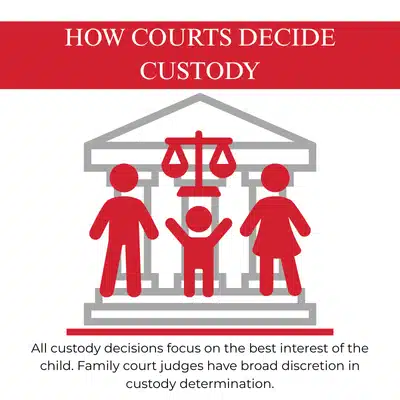When parents go through a divorce or separation, they are faced with difficult decisions about child custody. These choices shape where children live, how parenting time arrangements are made, and who holds the authority to make important decisions. Understanding the different custody types
KIJU can make a custody proceeding smoother and help parents create a custody order that works best for their family.
Physical custody and legal custody serve different roles but are equally important. Physical custody focuses on where a child lives each day and how the custody schedule is set, while legal custody determines who makes major decisions about healthcare, education, and religion. A custody evaluation may also be part of the custody proceeding to ensure the child’s best interests are met.
By working together on a fair custody schedule and following it consistently, parents can create stability for their children and build a healthy routine that supports their well-being.

Physical custody defines your child’s living situation and day-to-day care. The parent with physical custody handles essentials like meals, school pickup, and bedtime routines while creating a stable home. In a custody proceeding, the court considers different custody types to determine what custody schedule best supports the child’s needs and long-term security.
The custodial parent is responsible for most daily parenting responsibilities, while the other parent generally follows a parenting time order. This often comes with a custody schedule that includes regular visitation, such as alternating weekends and some weekday evenings. In Texas, a standard possession order might also expand the custody schedule during summer and holidays, helping both parents stay involved.
Texas law favors arrangements that keep both parents engaged whenever safe and possible. Even when one parent has sole physical custody, the focus is still on meaningful parent-child relationships. Courts may order child support to maintain balance, and by following a fair custody schedule, families can create routines that support stability and growth.
A legal custody order gives parents the right to make major parenting decisions for their child. A parent with legal custody can choose schools, approve medical treatment, and guide religious upbringing. It does not cover daily living arrangements or the custody schedule, but instead focuses on long-term welfare and the most important parenting choices.
Joint legal custody means both parents share decision-making power. This type of arrangement requires strong communication and cooperation. When parents struggle to agree, they may need custody mediation or court intervention to resolve disputes.
A parenting time order often works alongside legal custody, setting rules for a visitation schedule and custody schedule. These details ensure both parents remain actively involved in their child’s life even when they do not live together full-time. Courts encourage plans that promote consistency and stability.
Sole legal custody gives one parent exclusive authority to make big decisions. Courts usually grant this when parents cannot cooperate or when one parent is unfit to share responsibilities. Texas courts generally prefer joint managing conservatorship, but exceptions are made if evidence proves otherwise.
Legal custody functions separately from physical custody. Parents can share joint legal custody even if one has sole physical custody, which allows one parent to provide the primary home while both continue to collaborate on key decisions. By following a fair custody schedule, families can balance stability at home with shared responsibility for their child’s future.

Joint custody means parents share responsibilities for their child’s care. Joint custody gives children substantial time with each parent rather than just one primary residence.
Joint custody doesn’t always mean a perfect 50/50 custody split. Common joint custody schedule options include alternating weeks or a 2-2-3 rotation. These parenting time arrangements can be customized to fit family needs.
A 2-2-3 joint custody schedule works like this: two days with Parent A, two days with Parent B, then three days back with Parent A before flipping. This pattern gives both parents regular time while keeping transitions manageable.
Joint custody requires high cooperation between parents. Both must coordinate logistics, maintain consistent rules, and communicate about their child’s needs. Success depends on agreeing about discipline and daily routines across two households.
Studies show children in healthy joint custody schedule arrangements often have better outcomes. They tend to show improved self-esteem and academic performance compared to sole custody situations.
However, joint custody isn’t right for every family. Courts won’t award joint custody if there’s a history of family violence or abuse. Even shared custody doesn’t eliminate child support obligations if one parent earns much more or has less parenting time.
Sole custody means one parent has most custody rights. This usually includes sole physical custody and may include sole legal custody too. The child lives primarily with one parent while the other gets limited parenting time.
In sole physical custody, the custodial parent’s home becomes the child’s primary home. The other parent typically follows a visitation schedule like every other weekend and some holidays.
Courts order sole custody when joint custody isn’t feasible or in the child’s best interest. Common reasons include unfitness due to abuse, domestic violence, chronic substance abuse, or long absence from the child’s life. Child safety always comes first in these custody cases.
The sole custodial parent handles almost all daily tasks alone. For the parent without custody, limited time and no decision-making power can be emotionally difficult. Following the custody order closely remains important.

All custody decisions focus on the best interest of the child. Family court judges have broad discretion in custody determination. They evaluate many factors to decide which custody arrangement will best serve the child’s welfare.
Key factors include the child’s age, needs, and health. Young children might benefit from one stable primary home. Older children might handle switching homes more easily.
Courts examine each parent’s ability to provide a stable, loving environment. They consider housing, work schedules, and support systems. A parent’s willingness to foster positive relationships with the other parent weighs heavily in decisions.
Any history of abuse, violence, neglect, or substance abuse weighs heavily against a parent in custody proceedings. Child safety is paramount. Courts may restrict or deny custody and visitation to protect children from dangerous parents.
For older children, typically age 12 and above in Texas, family court may consider the child’s wishes. While not the deciding factor, a mature child’s reasonable preference can influence the custody decision when it serves their best interest.
A detailed parenting plan serves as the roadmap for co-parenting after separation. This custody agreement specifies each parent’s parenting time, holiday schedules, exchange procedures, and special arrangements. Clear plans prevent confusion and conflict.
Many custody schedule options work for different families. Besides alternating weeks, some families use 3-4-4-3 rotations or simple every-other-week patterns. The right choice depends on children’s ages, parents’ work schedules, and distance between homes.
Texas courts often use parenting time order schedules when parents can’t agree. The Standard Possession Order gives non-custodial parents the 1st, 3rd, and 5th weekends monthly, Thursday evenings during school, alternating holidays, and extended summer time.
Parents can agree to different arrangements, including true 50/50 splits, if they better suit their situation. Courts usually honor reasonable custody agreements.
Many parenting plan documents include dispute resolution provisions. Custody evaluation or neutral third-party consultation can help resolve disagreements without custody battles. Courts encourage alternative solutions to settle custody disputes cooperatively.
Once approved, the parenting plan becomes a binding custody order both parents must follow. Violating the order can result in court enforcement actions. If circumstances change significantly, parents can request modifications in a custody proceeding.

Different child custody arrangements shape parenting dynamics after separation. Joint custody keeps both parents deeply involved in their child’s upbringing. This arrangement benefits children by providing continuous contact and emotional support from both parents.
Parents sharing custody must coordinate schedules, cooperate on rules, and jointly make decisions in their child’s best interest. While challenging, this often leads to more balanced responsibilities.
Sole custody creates different dynamics. One parent carries almost all daily responsibilities and decision-making. The other parent’s role becomes more secondary.
The custodial parent should encourage positive relationships with the other parent when safe. Being flexible with visitation and keeping the other parent informed about school and health matters helps.
Custody arrangements also affect child support and financial responsibilities. The parent with majority time typically receives child support from the other parent. This helps cover housing, food, clothing, and other child expenses.
Both parents retain basic custody rights and duties unless a court explicitly removes them. Good parenting can happen under any custody arrangement when adults focus on children’s needs. High parental conflict harms children while cooperation leads to better outcomes.
Understanding custody helps you make informed decisions during separation. Whether you pursue joint or sole custody, focus on creating a stable environment for your child. Remember that custody isn’t about winning between parents – it’s about allocating time and responsibilities in the best way for your child’s future.
If you’re facing a custody matter in Texas, consult with us who understand local custody laws. They can help craft a parenting plan that suits your unique family situation and protects your custody rights. Don’t wait to secure your child’s future and your role as their parent.